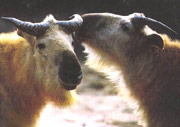|
 Takin (Budorcas taxicolor) Takin (Budorcas taxicolor)
The takin is mainly distributed in the forest and shrubbery with an altitude of 1500-4000 meters in the Wolong Natural Reserve. In summer, it prefers to live in the higher mountains while in winter it often moves down. Though having a rough temper, takins live in society. They move about mostly at night. The diet of the takin mainly consists of green grass, twigs. It usually ruts and mates in the months between June and August. A pregnant female takin often gives birth to one cub in March or April. An alpine animal only found in the Himalayan intersectional mountain range, the takin is listed in Appendices I of CHINA'S NATIONAL LIST FOR SPECIALLY PROTECTED WILD ANIMALS as a species threatened to be extinct.
snow leopard (Panthera uncia)
The snow leopard is mainly distributed in the shrubberies, meadows and bare rocks of the Wolong Natural Reserve. Nocturnal in its habits, the snow leopard often moves in a relatively fixed path. As a carnivorous animal, the snoe leopard mainly feeds on blue sheep, goas, plateau rabbit, conies and alpine marmot. It usually ruts and mates in the months between March and May. After 93 to 110 days' pregnancy, a pregnant female snow leopard often gives birth to two or three cubs. As a rare plateau animal, it also has significant value to scientific research. In CHINA'S NATIONAL LIST FOR SPECIALLY PROTECTED WILD ANIMALS, it is listed in Appendices I as a species threatened to be extinct.
Neofelis nebulosa (clouded leopard)
The clouded leopard is mainly distributed in the broadleaved forest of the Wolong Natural Reserve. Arboreal in its habits, the clouded leopard often moves alone along hillcrest following the footsteps of ungulates. Light and agile in moving, it hunts wild fowls, medium-size mammals for food; sometimes, however, it may also attack large-size ungulates. The heat period varies, often in late autumn or early spring. After about three months' pregnancy, a pregnant female clouded leopard often gives birth to two cubs. In CHINA'S NATIONAL LIST FOR SPECIALLY PROTECTED WILD ANIMALS, the Clouded Leopard was listed in Appendices I as a species threatened to be extinct.
Leopard (Panthera pardus)
The leopard is mainly distributed in the mountain broadleaved forest with an altitude of less than 2600 meters in the Wolong Natural Reserve. Arboreal in its habits, the leopard often moves alone and makes its home in the hedge, bush, or caves in rocks or big trees. Following the footsteps of animals along hillcrests or hillsides, it ambushes elks, wild rabbits, boars for food; but sometimes, it also feeds on and even store wild fowls, monkeys, sambars (cervus unicolor), young giant pandas, and domestic fowls. The mating season of the leopard is uncertain. After about 100 days' pregnancy, a pregnant female leopard often gives birth to one to four cubs. In CHINA'S NATIONAL LIST FOR SPECIALLY PROTECTED WILD ANIMALS, the Clouded Leopard was listed in Appendices I as a species threatened with extinction
The Tibetan macaque (Macaca thibetana)
The Tibetan macaque is mainly distributed in the subtropical evergreen broadleaved forest or the mixed deciduous forest, as well as the forest shrubberies along river valleys in the Wolong Natural Reserve. Diurnal in its habits, the tibetan macaque has no fixed home. Divided into several groups, the big family of Tibetan macaques often hug into a circle-the young macaques in the center-when they are sleeping beside a stone wall. A small family of Tibetan macques often consists of 20 to 40 members while a big one consists of as many as 50 to 70. The strong male macaques lead the whole family; but when those "monkey kings" become old, they live in solitude off the family. The vertical migration phenomenon is also found in the Tibetan macaque. The diet of the Tibetan macaque mainly consists of vegetarian foods: tree leaves, seeds and fruits, bamboo shoots; but sometimes it may also eat some lizards and small birds. In autumn, the macaques may take corn and other crops for food. The mating season of the Tibetan macaque can be all through the year. After about six months' pregnancy, a pregnant female macaque often gives birth to one cub or two cubs occasionally, mostly in April or May. A species peculiar to China, In CHINA'S NATIONAL LIST FOR SPECIALLY PROTECTED WILD ANIMALS, the Clouded Leopard was listed in Appendices II as a species threatened with extinction.
The Giant Panda.The Red Panda.The Golden Money.the White-Lipped Deer (Cervus albirostris).White-rumped deer
The rhesus macaque.The Sambar.The goral.The Serow.The Burhel
|



